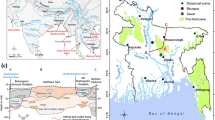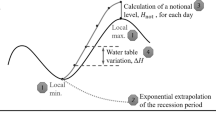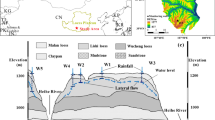Abstract
Understanding recharge is an important step in quantifying the sustainability and vulnerability of the groundwater reserve and promoting the adequate implementation of management policies. In southern Brazil, the Guarani Aquifer System (SAG) is increasingly utilised as a source of water for both rural and urban populations and agricultural activities. Being 90% confined, the regional SAG outcrop zones are generally considered the recharge areas, yet local recharge mechanics have yet to be constrained. Water table time series data over a 2-year period from 21 monitoring wells in the southern outcrop zone were investigated to assess the local recharge of the SAG. Recharge estimates calculated using the water table fluctuation (WTF) method were compared to the time series data in terms of auto- and cross-correlation factors. In turn, alluding to the memory effect of the water table that is controlled by the flow pathways to the well and its response to local rainfall events, it is apparent that the local conditions strongly affect water percolating through the unsaturated zone, with evidence of both matrix and preferential flow pathways feeding the monitoring sites. Matrix flow is broadly occurring within the study area, and preferential flow has a more restricted occurrence yet is associated with the highest rate of recharge. Although future studies may quantify the actual recharge amount related to each mechanism, this work explicitly shows that preferential flow mechanisms should not be ignored, providing insight into aquifer sustainability and its vulnerability to modern contaminants.






Similar content being viewed by others
Data availability
The data that support the findings of this study are openly available in RIMAS web (https://rimasweb.sgb.gov.br/layout/) and RHN (https://www.snirh.gov.br).
References
Beven K, Germann P (2013) Macropores and water flow in soils revisited. Water Resour Res. https://doi.org/10.1002/wrcr.20156
Cai Z, Offetinger U (2016) Analysis of groundwater-level response to rainfall and estimation of annual recharge in fractured hard rock aquifers, NW Ireland. J Hydrol. https://doi.org/10.1016/j.jhydrol.2016.01.066
Crossbie RS, Binning P, Kalma JD (2005) A time series approach to inferring groundwater recharge using the water table fluctuation method. Water Resour Res. https://doi.org/10.1029/2004wr003077
Delbrat C, Valdes D, Barbecot F, Tognelli A, Richon P, Chouchoux L (2014) Temporal variability of karst aquifer response time established by the sliding-windows cross-correlation method. J Hydrol. https://doi.org/10.1016/j.jhydrol.2014.02.008
Delin G, Healy R, Lorenz D, Nimmo J (2007) Comparison of local- to regional-scale estimates of ground-water recharge in Minnesota, USA. J Hydrol. https://doi.org/10.1016/j.jhydrol.2006.10.010
Gastmans D, Veroslavsky G, Kiang CH (2012) Hydrogeological conceptual model for Guarani Aquifer System: a tool for management [Modelo hidrogeológico conceptual del Sistema Acuífero Guaraní (SAG): Una herramienta para la gestión]. Bol Geol y Min 123:249–265
Gastmans D, Mira A, Kirchheim R, Vives L, Rodríguez L, Veroslavsky G (2017) Hypothesis of groundwater flow through geological structures in Guarani Aquifer System (GAS) using chemical and isotopic data. Procedia Earth Planet Sci. https://doi.org/10.1016/j.proeps.2016.12.030
Gomes AA, Rodrigues LB, Vives LS (2010) The Guarani Aquifer System: estimation of recharge along the Uruguay-Brazil border. Hydrogeol J. https://doi.org/10.1007/s10040-010-0630-0
Good SP, Noone D, Bowen G (2015) Hydrologic connectivity constrains partitioning of global terrestrial water fluxes. Science. https://doi.org/10.1126/science.aaa593
Healy RW (2010) Estimating groundwater recharge. Cambridge University Press, Cambridge. https://doi.org/10.1017/CBO9780511780745
Healy RW, Cook PG (2002) Using groundwater levels to estimate recharge. Hydrogeol J. https://doi.org/10.1007/s10040-001-0178-0
Hirata R, Foster S (2020) The Guarani Aquifer System—from regional reserves to local use. QJEGH. https://doi.org/10.1144/qjegh2020-091
Lanini S, Caballero Y, Seguin J, Maréchal J (2015) ESPERE—a multiple-method microsoft excel application for estimating aquifer recharge. Groundwater. https://doi.org/10.1111/gwat.12390
Larocque M, Mangin A, Razack M, Banton O (1998) Contribution of correlation and spectral analyses to the regional study of a large karst aquifer (France). J Hydrol. https://doi.org/10.1016/S0022-1694(97)00155-8
Lee JY, Yi MJ, Hwang D (2005) Dependency of hydrologic responses and recharge estimates on water-level monitoring locations within a small catchment. Geosci J. https://doi.org/10.1007/BF02910588
Lee LJE, Lawrance DSL, Price M (2006) Analysis of water-level response to rainfall and implications for recharge pathways in the Chalk aquifer, SE England. J Hydrol. https://doi.org/10.1016/j.jhydrol.2006.04.025
Lucas M, Wenland E (2016) Recharge estimates for various land uses in the Guarani Aquifer System outcrop area. Hydrol Sci J. https://doi.org/10.1080/02626667.2015.1031760
Mangin A (1984) Pour une meilleure connaissance des systems hydrologiques à partir des analyses correlatoire et spectrale. J Hydrol 67:25–43
Manna F, Walton KA, Cherry JA, Parker BL (2017) Mechanisms of recharge in a fractured porous rock aquifer in a semi-arid region. J Hydrol. https://doi.org/10.1016/j.jhydrol.2017.10.060
Manzione RL (2018) Physical-based time series model applied on water table depths dynamics characteristics simulation. Planet Sci. https://doi.org/10.1590/2318-0331.0318170071
Nimmo JR (2011) Preferential flow occurs in unsaturated conditions. Hydrol Process. https://doi.org/10.1002/hyp.8380
Nimmo JR, Horowitz C, Mitchell J (2015) Discrete-storm water table fluctuation method to estimate episodic recharge. Groundwater. https://doi.org/10.1111/gwat.12177
Ortega L, Miller J, Araguás-Araguás L, Zabala ME, Vives L, Mira A, Rodríguez L, Heredia J, Armengol S, Manzano M (2022) Unravelling groundwater and surface water sources in the Esteros del Iberá Wetland Area: an isotopic approach. Sci Total Environ. https://doi.org/10.1016/j.scitotenv.2022.157475
Riquetti N, Mello CR, Beskow S, Viola M (2020) Rainfall erosivity in South America: current patterns and future perspectives. Sci Total Environ. https://doi.org/10.1016/j.scitotenv.2020.138315
Rörig FS, Reginato PA (2023) Analysis and interpretation of natural variations in water table and groundwater recharge of coastal aquifer system in the coastal plain of Rio Grande do Sul, Brazil. Environ Earth Sci. https://doi.org/10.1007/s12665-023-11023-w
Santarosa LV, Gastmans D, Sitolini TP, Kirchheim RE, Betancurt SB, Oliveira ME, Campos JC, Mazione RL (2021) Assessment of groundwater recharge along the Guarani aquifer system outcrop zone in São Paulo State (Brazil): an important tool towards integrated management. Environ Earth Sci. https://doi.org/10.1007/s12665-021-09382-3
Schuller P, Campanya J, Moe H, Doherty D, Williams NH, McCormack T (2022) Mapping the groundwater memory across Ireland: a step towards a groundwater drought susceptibility assessment. J Hydrol. https://doi.org/10.1016/j.jhydrol.2022.128277
Stumpp C, Kammerer G (2022) The Vadose zone—a semi-aquatic ecosystem. In: Mehner T, Tockner K (eds) Encyclopedia of inland waters, 2nd edn. Elsevier, Amsterdam. https://doi.org/10.1016/B978-0-12-819166-8.00179-1
Wenland E, Gomes LH, Troeger U (2015) Recharge contribution to the Guarani Aquifer System estimated from the water balance method in a representative watershed. Ann Braz Acad Sci. https://doi.org/10.1590/0001-3765201520140062
Xiang W, Si Cheng B, Biscas A, Li Z (2019) Quantifying dual recharge mechanisms in deep unsaturated zone of Chinese Loess Plateau using stable isotopes. Geoderma. https://doi.org/10.1016/j.geoderma.2018.10.006
Yang L, Qi Y, Zheng C, Andrews C, Yue S, Lin S, Li Y, Wang C, Xu Y, Li H (2018) A modified water table fluctuation method to characterize regional groundwater discharge. Water. https://doi.org/10.3390/w10040503
Foster S, Hirata R, Vidal A, Schmidt G, Garduño H (2009) The Guarani Aquifer Initiative—towards realistic groundwater management in a transboundary context. Sustainable Groundwater Management Series, GW-MATE/World Bank, Washington
Heppner CS, Nimmo JR (2005) A computer program for predicting recharge with a master recession curve. US Geological Survey Scientific Investigations Report 2005-5172
LEBAC (2008) Informe Final de Hidrogeologia do Projeto Aquífero Guarani. Final repport—Consórcio Guarani
Lerner DN, Issar AS, Simmers I (1990) Groundwater recharge: a guide to understanding and estimating natural recharge. Volume 8 of international contributions to hydrogeology (ISSN 0936-3912)
Machado JLF (2005) Compartimentação Espacial e Arcabouço Hidroestratigráfico do Sistema Aquífero Guarani no Rio Grande do Sul. Thesis. Universidade do Vale do Rio dos Sinos
Mattiuzi CDP, Worth FS, Kirchheim R, Collischonn W, Reginato PAR, Fan FM (2015) Comparação de métodos de estimativa de recarga aquífera aplicados à Bacia do Rio Ibicuí/RS. https://rigeo.cprm.gov.br/jspui/bitstream/doc/15057/1/PAP021003.pdf Accessed July 2023
Maziero TA, Wendland E (2005) Avaliação da recarga subterrânea de bacias urbanas no município de São Carlos, SP. Simpósio de Hidrogeologia do Sudeste. Brasil
Milani EJ (1997) Evolução tectono-estratigráfica da Bacia do Paraná e seu relacionamento com a geodinâmica fanerozóica do Gondwana sul-ocidental: Doctoral Thesis, Universidade Federal do Rio Grande do Sul, Brazil
Melati MD, Kich EM, Teixeira ZA, Athayde GB (2017) Aplicação do método Water Table Fluctuation usando a master recession curve (MRC) para um poço localizado na Bacia Sedimentar do Araripe. XX Simpósio Brasileiro de Recursos Hídricos
Organization of American States (2009) Report on the project for environmental protection and sustainable development of the Guarani Aquifer System. Guarani Aquifer: strategic action program Acuífero Guaraní: programa estatégico de acción.– Bilingual edition.– Brazil; Argentina; Paraguay; Uruguay. OAS. https://www.oas.org/DSD/WaterResources/projects/Guarani/SAP-Guarani.pdf
Rutledge AT (1998) Computer programs for describing the recession of ground-water discharge and for estimating mean ground-water recharge and discharge from streamflow 215 records—U.S. geological survey water-resources investigations report. https://doi.org/10.3133/wri934121
Santos JR, Manzione RL (2018) Recharge of the Guarani Aquifer system in outcrop area in Bofete-SP. XX CABAS. Campinas, Brasil
Sapriza G, Gastmans D, Santos J, Flaquer A, Chang KH, Guimaraens M, Paula e Silva F (2011) Numerical flow model of Guarani Aquifer System (GAS) in outcrop region—Artigas (Uy)/Quarai (Br). Águas Subterrâneas. https://doi.org/10.14295/ras.v25i1.17533
Soares AP, Soares PC, Bettú DF, Holz M (2007) Compartimentação estrutural da Bacia do Paraná: A questão dos lineamentos e sua influência na distribuição do Sistema Aquífero Guarani. Doctoral Thesis. Universidade do Estado de Sao Paulo
Vives L, Campos H, Candela L, Guarracino L (2001) Modelación del acuífero Guaraní. Boletín Geológico y Minero
Acknowledgements
Authors would like to thank the support and data availability to the Geological Survey of Brazil. Authors also acknowledge the support of the Institute of Hydraulic Research of Federal University of Rio Grande do Sul and the valuable suggestions made by the anonymous reviewers.
Funding
The authors declare that no funds, grants, or other support were received for conducting this study.
Author information
Authors and Affiliations
Contributions
All authors contributed to the study conception and design. Material preparation, data collection and analysis and the draft of the manuscript were made by IAK. All authors commented on the manuscript and approved the final version.
Corresponding author
Ethics declarations
Conflict of interest
The authors have no financial or non-financial interests to disclose.
Additional information
Publisher's Note
Springer Nature remains neutral with regard to jurisdictional claims in published maps and institutional affiliations.
Rights and permissions
Springer Nature or its licensor (e.g. a society or other partner) holds exclusive rights to this article under a publishing agreement with the author(s) or other rightsholder(s); author self-archiving of the accepted manuscript version of this article is solely governed by the terms of such publishing agreement and applicable law.
About this article
Cite this article
Kuhn, I.A., Reginato, P.A.R., van Rooyen, J. et al. Unravelling recharge mechanisms along the Guarani aquifer system (SAG) outcrop in southern Brazil. Environ Earth Sci 83, 173 (2024). https://doi.org/10.1007/s12665-024-11495-4
Received:
Accepted:
Published:
DOI: https://doi.org/10.1007/s12665-024-11495-4




